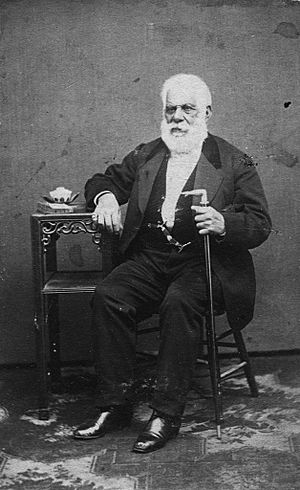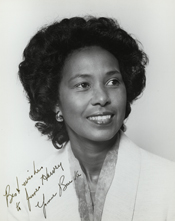History of African Americans in Los Angeles facts for kids
The History of African Americans in Los Angeles shows how Black people have made big contributions to the city's arts, culture, science, education, building design, and politics.
Contents
Early Days: Spain and Mexico
In 1781, Los Angeles was founded. Among its first settlers were about two dozen people of African and Spanish heritage from the Spanish colonies in California.
Pío Pico was a very important person. He was California's last governor when it was still under Mexican rule. Pico had a mixed background, including Spanish, Native American, and African roots. He lived his final years in Los Angeles and passed away in 1894. His family members were also important figures during that time.
After Mexican Rule
After California became part of the United States in 1848, Black and mixed-race people started facing legal unfairness. Many white Southerners who came to California during the Gold Rush brought their racist ideas with them.
In 1850, only twelve Black people were officially living in Los Angeles. Not many Black people moved to Los Angeles before 1865, because slavery was still allowed in some places until then. But by the 1880s, more Black people began to arrive, especially with the building of the Santa Fe Railroad. By 1900, Los Angeles was home to 2,131 African Americans, making it the city with the second-largest Black population in California.
In 1872, the First African Methodist Episcopal Church of Los Angeles (First A.M.E.) was started. A Black nurse and successful businesswoman named Biddy Mason, along with her son-in-law Charles Owens, helped create this church. Today, it has over 19,000 members.
The 20th Century
Between the 1890s and 1910, many African Americans moved to Los Angeles. They came from Southern states like Texas and Louisiana. They were looking to escape the unfair treatment and violence they faced in the Southern United States.
Los Angeles had a larger African-American population than many other Western cities. This was partly because of the Southern Pacific and Transcontinental railroads. By 1910, there were 7,599 African Americans in the city. The first California branch of the NAACP, an organization that fights for civil rights, was started in Los Angeles in 1913.
In the early 1900s, it was common for housing to be separated by race. Many property deeds actually said that owners could not sell homes to anyone who wasn't white.
From about 1920 to 1955, Central Avenue was a lively center for the African-American community in Los Angeles. It was famous for its exciting rhythm and blues and jazz music scenes.
Even fire stations were separated by race. Fire Station No. 30 and Fire Station No. 14 were segregated in 1924. They stayed separated until 1956, when the Los Angeles Fire Department finally allowed all races to work together.
In 1928, World War I veteran William J. Powell started the Bessie Coleman Aero Club. In 1931, Powell organized the first all-Black air show in the United States in Los Angeles. This event attracted 15,000 visitors! Powell also created a school to teach people how to become pilots and airplane mechanics.
World War II brought a huge change. Tens of thousands of African Americans moved to California during what is called the Second Great Migration. They mostly came from states like Louisiana and Mississippi. They left the segregated South to find better chances in California, especially with factory jobs available for the war effort. In 1940, the Black population in Los Angeles was 63,700.
In 1965, there were major protests in the Watts area of Los Angeles. These events were sparked by the arrest of a young Black man. They showed the deep anger and frustration felt by African American citizens who had faced unfair treatment, poor housing, and limited access to good education and healthcare. As a result, the King-Drew Hospital in Willowbrook opened in 1972. It was built to provide better hospital services to the area.

In 1973, Tom Bradley was elected as Mayor of Los Angeles. He was the first African American mayor of the city and served for 20 years. This made him the longest-serving mayor in Los Angeles history.
The 21st Century
In 2004, the music studio of famous singer-songwriter Ray Charles was named a historic landmark. He had moved to Los Angeles in 1950.
Where People Live and Population Changes
Mid-20th Century
By the 1950s and 1960s, several communities in South Los Angeles became mostly African-American. These included areas like Baldwin Hills and Watts. Between 1965 and 1970, nearly 100,000 Black people moved to Los Angeles.
Late 20th Century Shifts
In 1970, Los Angeles had 763,000 African Americans, making them the second-largest minority group in the city. Los Angeles had the biggest Black population on the West Coast.
During the 1990s, many African Americans started moving away from the older Black neighborhoods in Los Angeles. They moved to suburbs in eastern Los Angeles County, like Moreno Valley, and also to cities in northern Los Angeles County, such as Palmdale and Lancaster. The Black population in these areas grew quickly. For example, the Black population of Moreno Valley increased by 27,500 people in the 1990s.
Today's Population
In the 2019 Census, about 9% of the people living in Los Angeles County identified as Black or African-American.
In the early 2000s, cities like Compton, Ladera Heights, and View Park had the highest number of Black residents. Other cities like Malibu had very few. Over time, the population of Compton, which used to be mostly African-American, became about 66% Latino and Hispanic by 2010.
New Black immigrants from Africa, the Caribbean, and other parts of the Americas have also arrived in Los Angeles in the 2000s. Groups from countries like Nigeria, Ethiopia, Jamaica, and Haiti have settled in African-American neighborhoods.
Challenges still exist for African Americans in Los Angeles. In 2021 and the 2020s, African Americans in Los Angeles County faced a higher risk for COVID-19 hospitalizations. Also, a significant number of homeless people in Los Angeles are African American, even though they make up a smaller percentage of the total population. Many African Americans in Los Angeles also experience poverty.
Notable People
Many famous African Americans have connections to Los Angeles:
- Yvonne Brathwaite Burke, an attorney from Los Angeles, made history as the first African American woman in the California Legislature. In 1972, she became the first African American woman from the West Coast elected to the U.S. Congress.
- Doja Cat, a musician with South African American heritage, was born and grew up in Los Angeles.
- Nat King Cole, a legendary singer and jazz pianist.
- Dorothy Dandridge, an actress who lived in Los Angeles, was the first Black actress to be nominated for an Academy Award for Best Actress in 1954. Many later stars have recognized her important contributions to film.
- Mervyn Dymally, a teacher and politician from Los Angeles, became the first African American to serve in the California State Senate in 1966. He later became Lieutenant Governor.
- Larry Elder, a talk radio host and politician.
- Etta James, known as "The Matriarch of R&B," was born in the Watts neighborhood of Los Angeles. She is famous for bridging rhythm and blues with rock and roll and has won many awards, including six Grammys.
- Florence Griffith Joyner (Flo-Jo), born and raised in Los Angeles, was an amazing athlete. At the 1988 Olympics, she won three gold medals. Her world records for the 100m and 200m still stand today, making her one of the fastest women ever.
- Carl Lewis, a track and field star, became famous at the 1984 Summer Olympics in Los Angeles, where he won four gold medals.
- Tim Moore (comedian), a comedian and actor.
- Regina King, an acclaimed actress and director.
- Charles Mingus, a jazz musician, was born in Los Angeles in 1922 and grew up in the Watts area.
- Tavis Smiley, a talk show host and author.
- Maxine Waters, a long-serving U.S. Representative.
- Georgia Ann Robinson was the first Black woman hired by the Los Angeles Police Department (LAPD) in 1919. She worked on cases involving young people and Black women, often helping them find social services instead of arresting them. She also worked to end segregation on beaches.
- Serena Williams, raised in Los Angeles, became the World No. 1 tennis player in 2002. Many consider her the greatest female tennis player in history. She has won four Olympic gold medals and holds many records.
|



